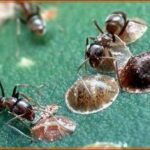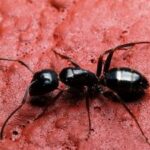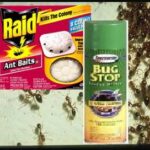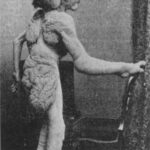John Ray discovered formic acid in 1671 long before it was given a name. Natural scientists noticed that anthills produced an acidic vapor (Laffitte 1). For his experiment, Ray collected and distilled dead ants. As a result, he was able to isolate formic acid (Laffitte 1). It is also known as methanoic acid and is classified as a carboxylic acid. It comes from the Latin word, “Formica”, which mean “ant” (Laffitte 1). It has a pH ranging from 2-3, which makes it a strong acid (Laffitte 2).
Joseph Gay-Lussac was the first to synthesize the compound from hydrocyanic acid. In 1855, French chemist Marcellin Berthelot synthesized formic acid from carbon monoxide (Laffitte 1). It is derived from methanol and carbon monoxide combined with a strong base to produce methyl formate. Next, it is combined with water to yield formic acid. This method is the most common. The reaction is seen below in the chemical equation (Laffitte 4). CH3OH + CO → HCOOCH3
Methanol Carbon Monoxide Methyl Formate
HCOOCH3 + H2O → HCOOH + CH3OH
Methyl Formate Water Formic Acid Methanol
Ants, specifically red ones, produce formic acid naturally to sting predators, capture food, and defend themselves (Bennett 189). Ants have a poison gland in their abdomen that contracts and releases the acid from their sting (Laffitte 2). In the Amazon rain forest, ants use formic acid to build their territory. When ants attack a plant, they inject formic acid into its leaves (Roach 1). It prevents any further growth and the plant eventually dies. This type of formic acid is also harmful to birds. It causes them to experience strange behaviors such as head and body tremors and leg pecking (Bennett 189).
At Northeast Forestry University, researchers analyzed the composition of two species of Northern Forest ants. As a result, they found that these ants were composed of 4.2 percent formic acid; the remaining components were protein, fat, and vitamin E (Yaqin 49). In the Lake Victoria region of Africa, ants are among many of edible insects. Residents use live ants to make salad dressing instead of vinegar (Ayieko 283). That is logical since formic acid is a by-product of acetic acid, and diluted acetic acid is vinegar (Laffitte 4).
In the textile industry, workers use formic acid for dying and finishing. People also use it as a fumigant to kill infested insects. In addition, it kills salmonella bacteria that can contaminate poultry (Laffitte 4). Since formic acid can form esters once reacted with alkenes, they are very useful for making perfumes. Esters are fragrant compounds used to add artificial flavor and scent (Laffitte 4).
People also use ants to make home remedies for inflammation, arthritis, and skin rashes. In Thailand, pregnant women believe that eating ants is beneficial for their growing babies’ health (Ayieko 283). As it has already been noted, ants are composed of mostly protein (Yaqin 49). Some even use ants to improve libido (Ayieko 283).
In conclusion, the ant has maintained a very significant role since the seventeenth century; they are more than just uninvited picnic guests. In addition to ants using formic acid as a natural defense, it has many other uses. People use ants for home remedies as well as a food source. Solvents that are used in making perfume are derived from formic acid combined with other chemicals. Today, it is in high demand in industry; it is used for textiles in addition to being used in the poultry industry. The ant may be small, but it is not weak.
Works Cited
Ayieko, Monica A. and Veronica Oriaro. “Consumption, Indigeneous Knowledge and Cultural
Values of the Lakefly Species Within the Lake Victoria Region” African Journal ofEnvironmental Science and Technology2(10) October 2008: 282-286.
Bennett, A.T.D., Cuthill, I.C., and M.H. Lloyd. “Ant-derived Formic Acid can be Toxic”. Chemoecology7(1996): 189-190.
Laffitte, Mathieu. “Formic Acid”. 06 February 2010 http://www.chm.bris.ac.uk/motm/formic/formich.htm.
Roach, John. “Ants Use Acid to Make “Gardens” in Amazon, Study Says”. 20 March 2006. 01 February 2010 <http://www.nationalgeographic.com/news/pf/73756548.html>.
Yaqin, Shi. “Composition Analysis and Research Development of Northern Forest Ants”. Journal of Forestry Research 5(4) December 1994: 49-51.






